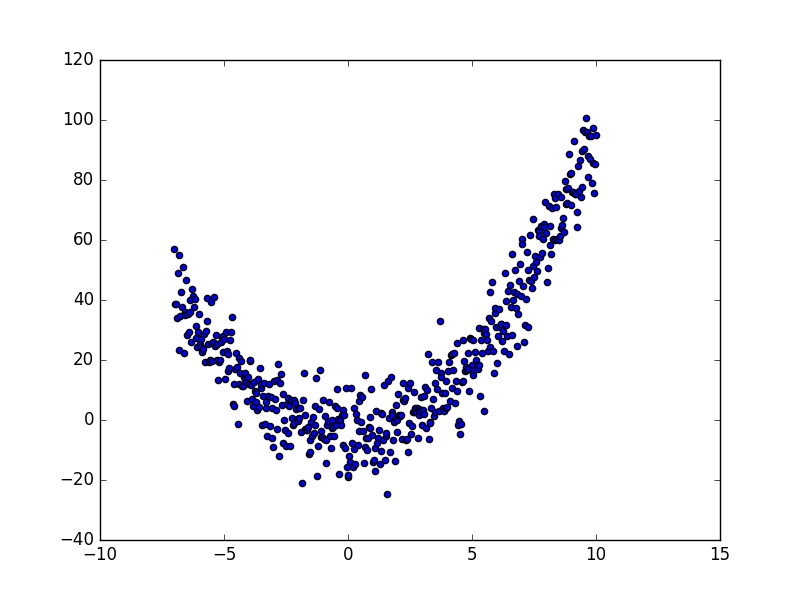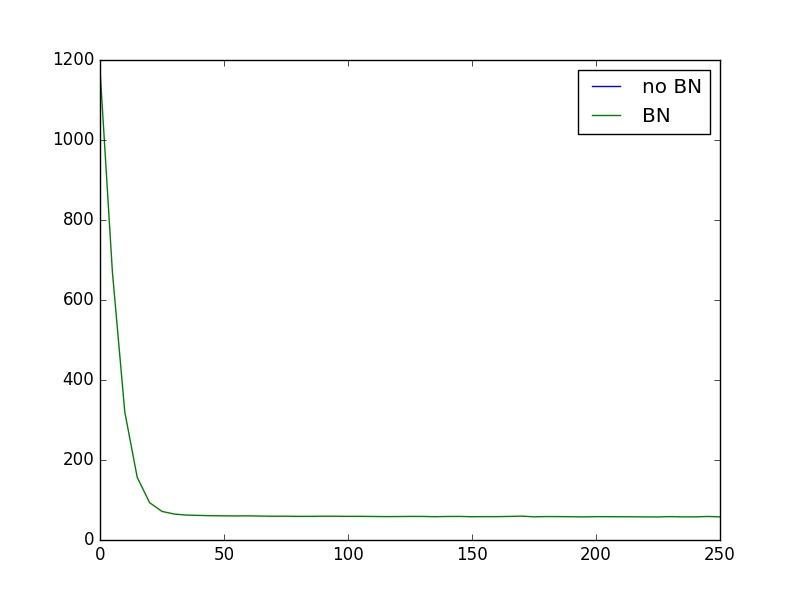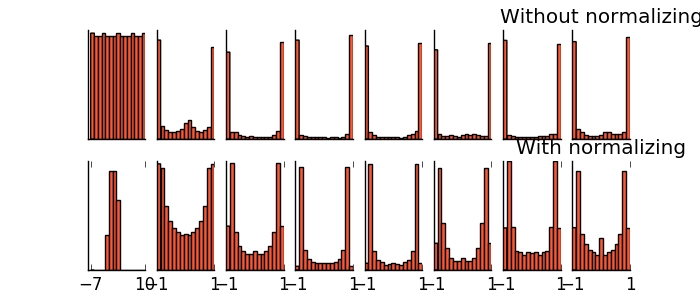import tensorflow as tf
import numpy as np
import matplotlib.pyplot as plt
tf.set_random_seed(1)
np.random.seed(1)
# Hyper parameters
N_SAMPLES = 2000
BATCH_SIZE = 64
EPOCH = 12
LR = 0.03
N_HIDDEN = 8
ACTIVATION = tf.nn.tanh
B_INIT = tf.constant_initializer(-0.2) # use a bad bias initialization
# training data
x = np.linspace(-7, 10, N_SAMPLES)[:, np.newaxis]
np.random.shuffle(x)
noise = np.random.normal(0, 2, x.shape)
y = np.square(x) - 5 + noise
train_data = np.hstack((x, y))
# test data
test_x = np.linspace(-7, 10, 200)[:, np.newaxis]
noise = np.random.normal(0, 2, test_x.shape)
test_y = np.square(test_x) - 5 + noise
# plot input data
plt.scatter(x, y, c='#FF9359', s=50, alpha=0.5, label='train')
plt.legend(loc='upper left')
# tensorflow placeholder
tf_x = tf.placeholder(tf.float32, [None, 1])
tf_y = tf.placeholder(tf.float32, [None, 1])
tf_is_train = tf.placeholder(tf.bool, None) # flag for using BN on training or testing
class NN(object):
def __init__(self, batch_normalization=False):
self.is_bn = batch_normalization
self.w_init = tf.random_normal_initializer(0., .1) # weights initialization
self.pre_activation = [tf_x]
if self.is_bn:
self.layer_input = [tf.layers.batch_normalization(tf_x, training=tf_is_train)] # for input data
else:
self.layer_input = [tf_x]
for i in range(N_HIDDEN): # adding hidden layers
self.layer_input.append(self.add_layer(self.layer_input[-1], 10, ac=ACTIVATION))
self.out = tf.layers.dense(self.layer_input[-1], 1, kernel_initializer=self.w_init, bias_initializer=B_INIT)
self.loss = tf.losses.mean_squared_error(tf_y, self.out)
# !! IMPORTANT !! the moving_mean and moving_variance need to be updated,
# pass the update_ops with control_dependencies to the train_op
update_ops = tf.get_collection(tf.GraphKeys.UPDATE_OPS)
with tf.control_dependencies(update_ops):
self.train = tf.train.AdamOptimizer(LR).minimize(self.loss)
def add_layer(self, x, out_size, ac=None):
x = tf.layers.dense(x, out_size, kernel_initializer=self.w_init, bias_initializer=B_INIT)
self.pre_activation.append(x)
# the momentum plays important rule. the default 0.99 is too high in this case!
if self.is_bn:
x = tf.layers.batch_normalization(x, momentum=0.4, training=tf_is_train) # when have BN
out = x if ac is None else ac(x)
return out
nets = [NN(batch_normalization=False), NN(batch_normalization=True)] # two nets, with and without BN
sess = tf.Session()
sess.run(tf.global_variables_initializer())
# plot layer input distribution
f, axs = plt.subplots(4, N_HIDDEN+1, figsize=(10, 5))
plt.ion() # something about plotting
def plot_histogram(l_in, l_in_bn, pre_ac, pre_ac_bn):
for i, (ax_pa, ax_pa_bn, ax, ax_bn) in enumerate(zip(axs[0, :], axs[1, :], axs[2, :], axs[3, :])):
[a.clear() for a in [ax_pa, ax_pa_bn, ax, ax_bn]]
if i == 0:
p_range = (-7, 10)
the_range = (-7, 10)
else:
p_range = (-4, 4)
the_range = (-1, 1)
ax_pa.set_title('L' + str(i))
ax_pa.hist(pre_ac[i].ravel(), bins=10, range=p_range, color='#FF9359', alpha=0.5)
ax_pa_bn.hist(pre_ac_bn[i].ravel(), bins=10, range=p_range, color='#74BCFF', alpha=0.5)
ax.hist(l_in[i].ravel(), bins=10, range=the_range, color='#FF9359')
ax_bn.hist(l_in_bn[i].ravel(), bins=10, range=the_range, color='#74BCFF')
for a in [ax_pa, ax, ax_pa_bn, ax_bn]:
a.set_yticks(())
a.set_xticks(())
ax_pa_bn.set_xticks(p_range)
ax_bn.set_xticks(the_range)
axs[0,0].set_ylabel('Pre_Ac')
axs[1,0].set_ylabel('pre_Ac_BN')
axs[2, 0].set_ylabel('Act')
axs[3, 0].set_ylabel('BN Act')
plt.pause(0.01)
losses = [[], []] # record test loss
for epoch in range(EPOCH):
print('Epoch: ', epoch)
np.random.shuffle(train_data)
step = 0
in_epoch = True
while in_epoch:
b_s, b_f = (step*BATCH_SIZE) % len(train_data), ((step+1)*BATCH_SIZE) % len(train_data) # batch index
step += 1
if b_f < b_s:
# print('b_f:',b_f,'\nb_s:',b_s)
b_f = len(train_data)
in_epoch = False
# print('\nstep:',step)
b_x, b_y = train_data[b_s: b_f, 0:1], train_data[b_s: b_f, 1:2] # batch training data
sess.run([nets[0].train, nets[1].train], {tf_x: b_x, tf_y: b_y, tf_is_train: True}) # train
if step == 1:
loss0, loss1, l_in, l_in_bn, pa, pa_bn = sess.run(
[nets[0].loss, nets[1].loss, nets[0].layer_input, nets[1].layer_input,
nets[0].pre_activation, nets[1].pre_activation],
{tf_x: test_x, tf_y: test_y, tf_is_train: False})
[loss.append(l) for loss, l in zip(losses, [loss0, loss1])] # recode test loss
plot_histogram(l_in, l_in_bn, pa, pa_bn) # plot histogram
print(losses)
plt.ioff()
# plot test loss
plt.figure(3)
plt.plot(losses[0], c='#FF9359', lw=3, label='Original')
plt.plot(losses[1], c='#74BCFF', lw=3, label='Batch Normalization')
plt.ylabel('test loss')
plt.ylim((0, 2000))
plt.legend(loc='best')
# plot prediction line
pred, pred_bn = sess.run([nets[0].out, nets[1].out], {tf_x: test_x, tf_is_train: False})
# print(list(zip(list(pred[120:130]),list(pred_bn[120:130]),list(y[120:130]))))
plt.figure(4)
plt.plot(test_x, pred, c='#FF9359', lw=4, label='Original')
plt.plot(test_x, pred_bn, c='#74BCFF', lw=4, label='Batch Normalization')
plt.scatter(x[:200], y[:200], c='r', s=50, alpha=0.2, label='train')
plt.legend(loc='best')
plt.show()







